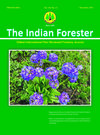Quantitative Analysis of Woody Vegetation in Subtropical forests of Himachal Pradesh, India
DOI:
https://doi.org/10.36808/if/2017/v143i11/119699Keywords:
Forest, Shrubs, Biodiversity, Shiwalik, Basal Area, Woody Vegetation.Abstract
The quantitative characteristic of woody vegetation was studied in five forest types of subtropical region viz., Bilaspur, Hamirpur, Solan and Sirmaur of Himachal Pradesh. A total of 41 species of woody vegetation including trees and shrubs were reported. Out of 41 species, 19 were treesbelonging to 17 genera, 14 families and 22 species of shrubs belonging to 16 genera and 17 families. Tree density is recorded maximum in lower Shiwalik pine forest community (710N ha-1) and minimum for Chir pine plantation community (370N ha-1). Shrub density is recorded maximum for northern mixed dry deciduous forest (12,320N ha ) and the minimum for Himalayan chir pine forest community (4,133N ha-1). Tree basal area (m21ha-1) was maximum for dry Shiwalik sal forest (46.42 m2ha-1). The minimum tree basal area was found in Chir pine plantation community (17.14 m2ha-1). Highest value of shrub basal area is observed for northern mixed dry deciduous forest community (11,94,502.94cm2ha-1) and least for dry Shiwalik sal forest (13,944 cm2ha-1).References
Ayensu, Claasen, R.D., Collins, M., Dearing, A., Fresco, L., Gadgil, M., Gitay, H., Glaser, G., Juma, C., Krebs, J., Lenton, R., Lubchenco, J., McNeely, J.A., Mooney, H.A., Pinstrup-Andersen, P., Ramos, M., Raven, P., Reid, W.V., Samper, C., Sarukhan, J., Schei, P., Tundisi, J.G., Watson, R.T., Guanhua, X. and Zakri, A.H. (1999). International ecosystem assessment,Science,286: 685-686.
Berkes, F., Kislalioglu, M.,Folke, C. and Gadgil, M. (1998).Exploring the basic ecological unit: ecosystem-like concepts in traditional societies,Ecosystems,1: 409-415.
Champion, H. G. and Seth, S. K. (1968). A revised survey of the forests types of India. Govt. of India Publications, New Delhi.404.pp
Curtis, J.T. and McIntosh, R.P. (1950). The interrelations of certain analytic and synthetic phytosociological characters,Ecology,31: 434-455.
Gadgil, M. (1994). Inventorying, monitoring and conserving India's biological diversity,Current Science,66(6): 401-406.
Gaston, K.J. (2000). Global Patterns in biodiversity,Nature,405: 220-227.
Gaur, U. N., Raturi, G. and Bhatt, A., (2005) Current vegetation pattern along glacial landscape in Central (Garhwal) Himalaya, India,Journal of Mountain Science., 2(3), 255-264.
Hardwick, K., Healey, J.R., Elliott, S. and Blakesley, D. (2005). Research need for restoring seasonal tropical forest in Thailand: accelerated natural regeneration,New Forest,27: 285-302.
Kesseler, M., Kebler, P. J.A., Gradstein, R., Batch, K., Schmull, M. and Pitopang, R. (2005).Tree diversity in primary forest and different landuse system in Central Sulawesi, Indonesia,Biodiversity and Conservation,14: 547-560.
Laurance,W.F. (2005).Alteredtree communities in undisturbed Amazonian forests: A consequence of global change?,Biotropica,37(2):160-162.
Negi, C. S. and Nautiyal, S. (2005). Phytosociological studies of a traditional reserve forest -ThalkeDhar, Pithoragarh, Central Himalayas,Indian Forester,13(4): 535.
Pala, N. A., Negi, A. K and Todaria, N. P. (2015).Ecological status and socio-cultural significance of Semmukhem temple landscape in Garhwal Himalaya, India,Indian Forester,141(5):496-504
Pala, N. A., Negi, A. K., Gokhale, Y and Todaria, N. P. (2013). Tree Regeneration status of sacred and protected landscapes in Garhwal Himalaya, India,Journal of Sustainable Forestry, 32:230–246, DOI:-10.1080/10549811.2013.762492
Pande, P. K., Negi, J. D. S. and Sharma, S. L. (2002).Plant species diversity composition. Gradient analysis and regeneration behaviour of some tree species in a moist temperate Western Himalayan forest ecosystem,Indian Forester,128(8): 869-885.
Pushpangadan, P., Ravi, K. and Santosh, V. (1997).Conservation and Economic Evaluation of Biodiversity. Vols. I-II. Oxford and IBH Publishing Co. Pvt. Ltd., New Delhi. Pp. 317-334
Rawal,R.S. and Dhar,U. (1997).Sensitivity of timberline flora in Kumaun Himalaya, India:Conservation,Arcticand Alpine Research,29(1):112-121.
Schuster, B. and Diekmann, M., (2005) Species richness and environmental correlates in deciduous forests of Northwest Germany,Forest Ecology and Management.,206(1), 197-205.
Shrestha, B. B. and Jha, P. K., (2009) Habitat range of two alpine medicinal plants in a trans-Himalayan dry valley, Central Nepal,Journal of Mountain Science.,6(1), 66–77.
Singh, J. S. and Singh, S. P.(1992).Forests of Himalaya: Structure, Functioning and Impact of Man, Gyanodaya Prakashan, Nainital. Pp.294
Singh, S. P., Rawat, Y. S. and Garkoti, S. C. (1997). Failure of brown oak (Quercussemicarpifolia) to regenerate in the Central Himalaya: a case of environmental semi-surprise,Current Science,73: 371-374
United Nations Environment Programme (UNEP). (1992). Convention on Biological diversity (CBD), UNEP, Montreal.
United Nations Environment Programme (UNEP). (1993). Guidelines for country studies on biological diversity. UNEP, Nairobi.
Downloads
Downloads
Published
How to Cite
Issue
Section
License
Unless otherwise stated, copyright or similar rights in all materials presented on the site, including graphical images, are owned by Indian Forester.





